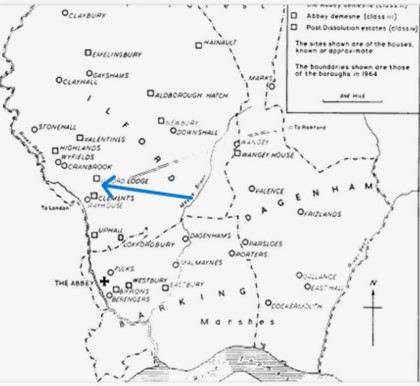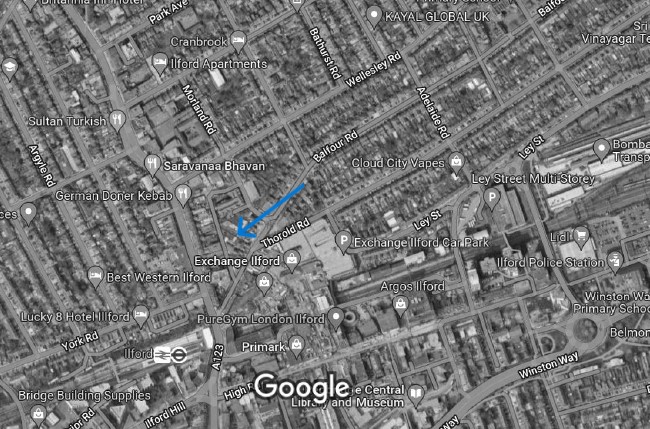
The aim of this short series of posts on the Essex homes (essentially northern Greater London, England) of Mabel’s kin – on her father’s side – is to give a quick look at the open spaces and sorts of landscapes that Mabel Bent (nee Hall-Dare) would have enjoyed as a young woman on the eastern shores of the Irish Sea, predisposing her to an adventurous, outdoor life – horses everywhere, rivers, forests, walks, new rail links, not to mention the travelling involved in getting up to Dublin from Co. Wexford and then across the sea to London (there were rented properties in ‘Town’ too of course), for stays in Essex before, for example, spending the long summers touring Europe with her siblings. Indeed, she was to meet her husband-to-be, Theodore Bent, in Norway on one such tour (although we still don’t know when, where, how, and why).
The Essex properties, lands, and churches featured include: (1) ‘Fitzwalters‘, (2) ‘East Hall‘, (3) ‘Ilford Lodge’, (4) ‘Cranbrook‘, (5) ‘Wyfields‘, ‘Theydon Bois’, and others, all with links in one way or another to Mabel Bent.
No. 3: Ilford Lodge – Ilford, Essex, UK.
Before AD 687, the Saxon king Œthelræd gave to the newly-founded abbey of Barking large parcels of land in the area, and over the subsequent centuries, further patronage, crown and mitre, established in this corner of Essex, after the Dissolution this is, estates such as Aldborough Hatch, Bifrons, Clements, Hainault, Highlands, Valentines, and Ilford Lodge, our subject.

The mansion of Ilford Lodge – hardly a lodge as we might think of one – was a late 18th-century edifice of yellow brick – a central block and side wings, all in three storeys. Fine enough, if not exactly characterful, although Edward Tuck (of whom much more later) thought it ‘distinguished’. It stood, suffering several vicissitudes, until demolishment as recently as 1960. It is unlikely that Mabel Bent ever slept under its roof, as the property was owned by soldier-uncle Frank, who, like Mabel, was hardly ever at home; but she may well have taken tea there – we can only guess.

The estate of the same name, dates only from the late 18th/early 19th centuries, and was just a short distance down a lane from another Hall-Dare mansion, ‘Cranbrook’, which is to feature in another of these posts. Incidentally, according to our Edward Tuck (p. 53) – “It may, in a passing remark, be said that the road shadowed by the beautiful trees and shrubs along this estate down to Cranbrook was one of the most charming walks in the neighbourhood.’ He would not write the same now.
Ilford Lodge had been carved from the much larger adjoining estate of Valentines, and it passed into the hands of Robert Hall, who was previously a tenant there, before 1810. It remained in the Hall-Dare families until 1883, when it was acquired by the larger-than-life character, and crook, Jabez Balfour, and his Liberator Building Society, which collapsed in 1892, and Balfour imprisoned for embezzlement. His story his well worth a read and for an amusing coincidence click here!

In 1896 the Ilford Lodge Estate was put up for sale as the ‘Ilford Park Estate’, sold, and subsequently developed into mostly residential housing – very much as can be seen on the maps today: no more gardens, gazebos, and children’s ponies grazing in the distance; pretty nondescript, suburban, a stone’s throw from Ilford railway station (opened 20 June 1839 for Eastern Counties Railway).

When the estate was sliced up for building, Ilford Lodge was preserved as a sports and social club for the local residents of Wellesley Road. As mentioned above, the roof under which Mabel never slept was torn down in 1960. Nothing remains.

But now it’s time for Tuck proper and an account of the mansion’s heyday; his work on this corner of Essex is unparalleled: “‘THE LODGE’. This once distinguished house, although not one of the Manors connected with the Abbey of Barking, held a very prominent position among the leading seats of the surrounding gentry. The mansion and estate was for a number of years owned and occupied by Robert Hall, Esq… Their family consisted of a son and a daughter. The son, Mr. Robert Wesley Hall… married the only daughter of Marmaduke Grafton Dare, and on their marriage took the name of Hall-Dare, omitting Grafton, through some dispute of the Grafton family… It appears that the Graftons were once Romford people. I found on a tomb in the Churchyard ‘John Marmaduke Grafton, died 1788,’ aged 70. His son (named also John Marmaduke Grafton) married Mrs. Dare, of Cranbrook, and assumed the name of Grafton-Dare. Some years after, Mrs. Grafton-Dare’s daughter became the wife of Robert Wesley Hall, and they assumed the name of Hall-Dare. On the death of Mr. Robert Hall-Dare [i.e. Mabel Bent’s grandfather] his widow succeeded to the estate, and outlived her husband for several years… On her demise the mansion and estate came, by will of the grandfather, to Captain Frank M. Hall-Dare, third son of Robert W. Hall-Dare, Esq., of Cranbrook.

Having entered the army when young, he did not occupy the estate, nor leave the army till after the Crimean War, where he gained… four medals… After the war he retired from the army, and spent most of his time in travel. He subsequently disposed of the estate to the Liberator Building Society [see above for the rogue Jabez Balfour]. The mansion is now used for a club-house, and the estate covered with residences…’ (Edward Tuck, pp.52-53)
Coming next: No. 4: ‘Cranbrook‘.
The back story
Of course Mabel was fortunate in that her family (on both sides) were landed (obviously) and comfortably off. Mabel’s paternal grandfather was the first of the Robert Westley Hall-Dares proper, an astute, baronial, figure who sat at the head of a coalition of wealthy and influential Essex families (Halls, Dares, Graftons, Mildmays, Kings, to name but a few), garnering in with him two major estates (Theydon Bois and Wennington) and various other demesnes, farms, and assorted dwellings, large and small. His wealth and assets were based on rents, farming, ventures, deals, and investments – including a sugar plantation in what is today British Guyana. This plantation, ‘Maria’s Pleasure‘, still retains its name, although it was disposed of after Mabel’s father, to whom the sugar estate had been left, received his compensation for the emancipation of around 300 slaves after Abolition (worth the equivalent of several millions of pounds now).
Robert Westley Hall-Dare the first (1789-1836), the Member of Parliament for South Essex from 1832 until his death, rubbed shoulders with the great and the good, not to mention London Society, but it was his son Robert Westley Hall-Dare the second (1817-1866) who actually married into (minor) aristocracy with his marriage to Frances, daughter of Gustavus Lambart of Beauparc, Co. Meath – Mabel (b. 1847) was one of their daughters.
Mabel was thus free to travel; her husband was the perfect fit; they were never slowed down by children. But if anyone should say to you, ‘Ah, but Mabel never worked’, then they don’t know what they are talking about: few women of her class would have sweated more, from Aksum to Great Zimbabwe.
References
Edward Tuck, A sketch of ancient Barking, its abbey, and Ilford (Barking, 1899?), pp.52-53.
The Ilford Recorder, 22 April 2017: ‘Heritage: The fraudster who gave our streets their names’
https://www.ilfordrecorder.co.uk/lifestyle/21197094.heritage-fraudster-gave-streets-names/
Ilford Historical Society Newsletter No.129, April 2019
For a photograph of Mabel’s uncle Francis Marmaduke Hall-Dare (1830-1897), past owner of Ilford Lodge, click here.
If you have any photographs or memories of Ilford Lodge pre-1960 we would be delighted to hear from you!
 Leave a comment or contact us about this article
Leave a comment or contact us about this article
